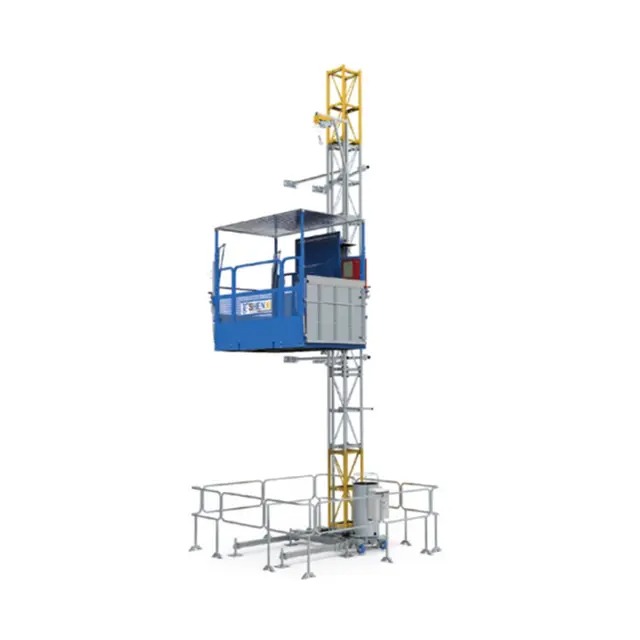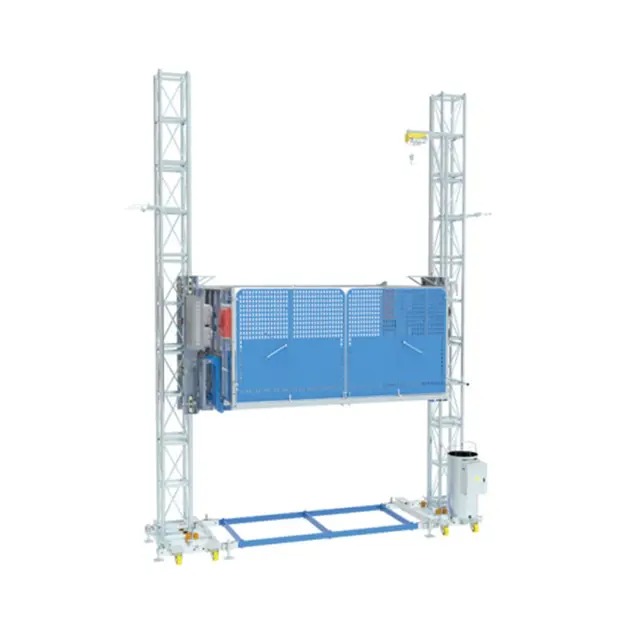




Views: 216 Author: Site Editor Publish Time: 2025-10-21 Origin: Site










In the construction and industrial sectors, the efficient movement of materials and personnel is paramount. Among the key machinery designed to improve vertical transportation on construction sites are construction hoists and material transport platforms. While both serve to facilitate the lifting and transport of goods and workers, they differ significantly in terms of design, functionality, applications, and safety features.
Understanding these differences is crucial for construction companies, engineers, and project managers to make informed decisions about the equipment that best suits their needs. This article will break down the distinctions between these two essential construction tools, focusing on their design features, advantages, safety considerations, and typical applications.
A construction hoist is a type of elevator system specifically designed to carry heavy materials, tools, and workers vertically on a construction site. These hoists are typically installed on building exteriors during the construction process, allowing quick and efficient transportation of heavy loads between different floors.
Vertical Movement: Construction hoists are primarily designed to move loads vertically over significant heights.
Heavy Lifting Capacity: They are capable of carrying both workers and large, heavy materials.
Enclosed Cages: Hoists often feature an enclosed cage to protect workers during transport.
High-Speed Operation: They are built for fast operations, ensuring that the construction process runs smoothly.
Permanent or Semi-Permanent Installation: These hoists are often fixed in place for long-term use during a building's construction phase.
High-Rise Buildings: Essential for transporting workers and building materials to upper floors.
Industrial Sites: Used in heavy industries for lifting bulk materials in plants and warehouses.
Large-Scale Projects: Common in projects requiring high lifting capacity over long durations.

Fast and Efficient: Construction hoists are designed for heavy-duty lifting, allowing for quick movement of goods and personnel.
Improved Safety: The enclosed design ensures that workers are safely transported, minimizing the risk of accidents.
Cost-Effective for Long-Term Use: For projects with ongoing material and personnel movement, hoists are more economical than temporary lifting methods.
A material transport platform (MTP) is a mechanical system designed to transport large quantities of materials horizontally or vertically across construction sites. Unlike the enclosed and heavier construction hoists, these platforms are often used for the transportation of materials such as concrete, steel, and other building components.
Horizontal and Vertical Movement: While primarily designed for vertical movement, some material transport platforms are capable of horizontal movement as well.
Open Design: Typically, MTPs have an open design, making them ideal for carrying bulk materials rather than people.
Lifting and Transporting Materials Only: Unlike hoists, material transport platforms are usually not designed for carrying workers.
Flexible Operation: These platforms can be used on construction sites with varying demands, moving different materials efficiently.
Material Movement in High-Rise Construction: Especially useful for the continuous transport of building materials from ground level to upper floors.
Industrial and Warehouse Settings: Can be used in factories for moving raw materials and products.
Scaffold Systems: Often used to move large scaffolding components and tools at construction sites.
Versatility in Transporting Materials: These platforms can move a wide variety of construction materials, making them versatile.
Lower Installation Cost: Since MTPs don't need to be permanently installed like hoists, they can often be more cost-effective.
Faster Unloading and Loading Times: Material transport platforms allow for quick unloading and loading, speeding up construction timelines.
While both systems are designed to enhance material handling on construction sites, there are several important distinctions that differentiate construction hoists from material transport platforms.
| Feature | Construction Hoist | Material Transport Platform |
|---|---|---|
| Design Type | Enclosed cage for people and materials | Open platform, typically for materials only |
| Primary Use | Lifting workers and materials vertically | Transporting materials across floors or horizontally |
| Capacity | High lifting capacity for both personnel and materials | Primarily for material transport with lower weight limits for workers |
| Safety Features | Enclosed design with safety mechanisms | Open design, but often equipped with rails and guardrails |
| Installation | Often semi-permanent or permanent | Portable and flexible in installation |
| Cost | Generally higher due to heavier lifting capacity and installation | Lower installation and operational cost |
| Speed | Faster lifting speeds for people and materials | Slower movement; designed for bulk material transport |
| Application | High-rise construction, industrial sites | Primarily used for material transport on construction sites |
Deciding whether to use a construction hoist or a material transport platform depends on several factors, including the type of project, the scale of operations, and the specific material-handling needs.
Heavy Lifting of Workers and Materials is Required: If your project involves moving both heavy materials and workers up and down a construction site, a hoist is the better choice.
Long-Term or High-Rise Projects: For projects involving high-rise buildings where the need for continuous vertical transport is essential, a construction hoist will provide the necessary lifting power.
Safety is a Primary Concern: Construction hoists provide an enclosed space for personnel, ensuring that safety standards are met for workers being transported.

Only Materials Need to be Moved: If your goal is to transport large quantities of materials, such as concrete or steel, and personnel don’t need to be transported, a material transport platform is more appropriate.
Cost Efficiency is Critical: Material transport platforms are often less expensive to install and operate, making them ideal for projects with tight budgets.
Temporary Transport Needs: If you need flexible, short-term material transport solutions, a platform can be moved as needed across the site.
Both construction hoists and material transport platforms play essential roles in modern construction projects. While they share the goal of facilitating efficient material and personnel transport, their designs, capabilities, and applications differ significantly. Construction hoists excel in lifting workers and heavy materials to great heights with safety and speed, whereas material transport platforms are best suited for moving bulk materials and are more cost-effective for temporary, flexible use.
By understanding the core differences, construction managers can make better equipment choices that optimize safety, efficiency, and budget management. Whether you need a high-capacity hoist for a skyscraper or a flexible platform for material transport, each tool offers unique advantages that contribute to a streamlined construction process.
1. What is the main difference between a construction hoist and a material transport platform?
The main difference lies in the capacity and design. Construction hoists are designed to lift both materials and workers in an enclosed space, typically for high-rise buildings, while material transport platforms are open and typically only used for transporting materials.
2. Can a material transport platform be used to carry people?
Material transport platforms are generally not designed for carrying people. They are mainly used for transporting heavy construction materials.
3. How long does it take to install a construction hoist?
Installation time varies based on the complexity of the project and the height of the building. Generally, a construction hoist takes several days to install, depending on the size and specific requirements.
4. Which system is better for high-rise construction projects?
For high-rise construction, construction hoists are often the preferred solution due to their ability to safely transport both workers and materials to great heights.
5. Are material transport platforms cost-effective?
Yes, material transport platforms are typically more cost-effective than construction hoists, especially for projects that do not require lifting workers along with materials.